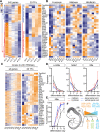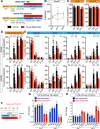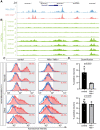A shared transcriptional code orchestrates temporal patterning of the central nervous system
- PMID: 34767545
- PMCID: PMC8612522
- DOI: 10.1371/journal.pbio.3001450
A shared transcriptional code orchestrates temporal patterning of the central nervous system
Abstract
The molecular mechanisms that produce the full array of neuronal subtypes in the vertebrate nervous system are incompletely understood. Here, we provide evidence of a global temporal patterning program comprising sets of transcription factors that stratifies neurons based on the developmental time at which they are generated. This transcriptional code acts throughout the central nervous system, in parallel to spatial patterning, thereby increasing the diversity of neurons generated along the neuraxis. We further demonstrate that this temporal program operates in stem cell-derived neurons and is under the control of the TGFβ signaling pathway. Targeted perturbation of components of the temporal program, Nfia and Nfib, reveals their functional requirement for the generation of late-born neuronal subtypes. Together, our results provide evidence for the existence of a previously unappreciated global temporal transcriptional program of neuronal subtype identity and suggest that the integration of spatial and temporal patterning mechanisms diversifies and organizes neuronal subtypes in the vertebrate nervous system.
Conflict of interest statement
The authors have declared that no competing interests exist.
Figures







Similar articles
-
Temporal patterning of the vertebrate developing neural tube.Curr Opin Genet Dev. 2024 Jun;86:102179. doi: 10.1016/j.gde.2024.102179. Epub 2024 Mar 14. Curr Opin Genet Dev. 2024. PMID: 38490162 Review.
-
Tgfβ signaling regulates temporal neurogenesis and potency of neural stem cells in the CNS.Neuron. 2014 Dec 3;84(5):927-39. doi: 10.1016/j.neuron.2014.10.033. Epub 2014 Nov 13. Neuron. 2014. PMID: 25467979
-
Specification of neuropeptide cell identity by the integration of retrograde BMP signaling and a combinatorial transcription factor code.Cell. 2003 Apr 4;113(1):73-86. doi: 10.1016/s0092-8674(03)00204-6. Cell. 2003. PMID: 12679036
-
Tcf/Lef repressors differentially regulate Shh-Gli target gene activation thresholds to generate progenitor patterning in the developing CNS.Development. 2011 Sep;138(17):3711-21. doi: 10.1242/dev.068270. Epub 2011 Jul 20. Development. 2011. PMID: 21775418 Free PMC article.
-
The route to spinal cord cell types: a tale of signals and switches.Trends Genet. 2015 Jun;31(6):282-9. doi: 10.1016/j.tig.2015.03.001. Epub 2015 Mar 27. Trends Genet. 2015. PMID: 25823696 Review.
Cited by
-
A GGC-repeat expansion in ZFHX3 encoding polyglycine causes spinocerebellar ataxia type 4 and impairs autophagy.Nat Genet. 2024 Jun;56(6):1080-1089. doi: 10.1038/s41588-024-01719-5. Epub 2024 Apr 29. Nat Genet. 2024. PMID: 38684900
-
mRNA Translation Is Dynamically Regulated to Instruct Stem Cell Fate.Front Mol Biosci. 2022 Mar 31;9:863885. doi: 10.3389/fmolb.2022.863885. eCollection 2022. Front Mol Biosci. 2022. PMID: 35433828 Free PMC article. Review.
-
Decoding gene networks controlling hypothalamic and prethalamic neuron development.Cell Rep. 2025 Jun 24;44(6):115858. doi: 10.1016/j.celrep.2025.115858. Epub 2025 Jun 12. Cell Rep. 2025. PMID: 40512619 Free PMC article.
-
A Spacetime Odyssey of Neural Progenitors to Generate Neuronal Diversity.Neurosci Bull. 2023 Apr;39(4):645-658. doi: 10.1007/s12264-022-00956-0. Epub 2022 Oct 10. Neurosci Bull. 2023. PMID: 36214963 Free PMC article. Review.
-
The Effects of Environmental Adversities on Human Neocortical Neurogenesis Modeled in Brain Organoids.Front Mol Biosci. 2021 Jun 24;8:686410. doi: 10.3389/fmolb.2021.686410. eCollection 2021. Front Mol Biosci. 2021. PMID: 34250020 Free PMC article. Review.
References
Publication types
MeSH terms
Substances
Grants and funding
LinkOut - more resources
Full Text Sources
Molecular Biology Databases

